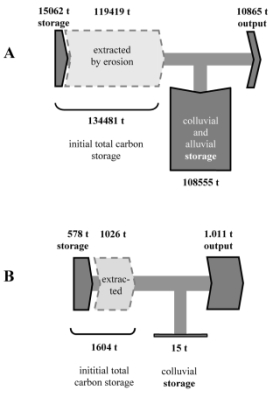Main-induced carbon flux
A comparison of budgets of carbon storage and transfer for Rockenberg catchment and a Stettbach subcatchment |
|
|
K.M. Moldenhauer and P. Houben |
|
|
Fig. 1 Budgets of carbon fluxes (A) for Rockenberg catchment and (B) for the Tannenberg headwater catchment in the Stettbach system. Carbon contents refer a modeled adsorption of carbon to soil particles for a solum thickness of 1 m. |
Storage of carbon in and translocation with detached soil material forms part of the global carbon cycle. Quantified storage of carbon in soils and quantitative estimates of soil reworking from sources to sinks and off the catchment allow for the coupling of sediment flux to a catchment-scale carbon budget. The content of total organic carbon (TOC) in soils can be estimated using an exponential function that relates land-use dependent carbon contents to soil depth (Moldenhauer and Emmerich, in prep.) The major difference in catchment carbon flux is marked by different relative proportions of within-catchment storage of carbon which is bound to reworked soil particles. The differences in carbon storage and export mainly reflect the difference of the virtual velocity of sediment transport along the sediment cascade. The prevalence of negligible carbon storage and its accelerated export from the Tannenberg subcatchment can be assigned to the widespread linear gully erosion, which predominates erosion and transport processes in this steeper sloping headwater catchment. |
|
|
<Back to project homepage> |
Acknowledgment
We gratefully acknowledge the DFG for funding this project as part of the RheinLUCIFS initiative.




